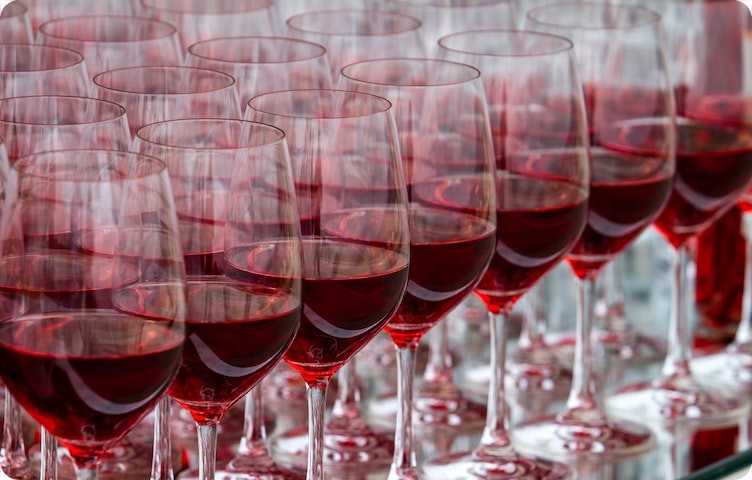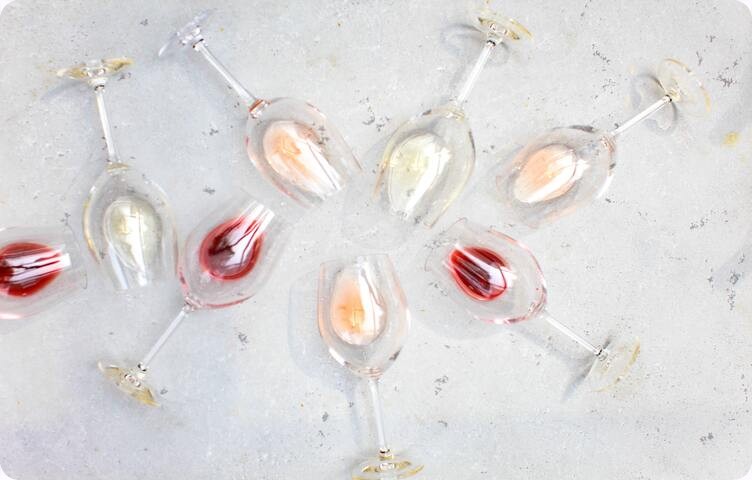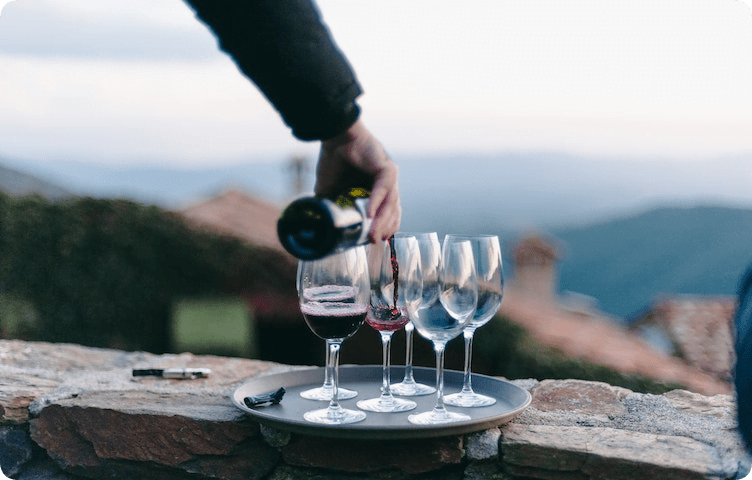Choosing wine to go with different dishes is an art. It is equally important to pour the drink into glasses that will maximize the taste and smell. But the range of wine glasses is very wide - products differ in shape, volume, diameter and material. Let's find out how glassware affects the quality of noble alcohol and learn how to select it for different types of product.
Why shape is important
The Court of Master Sommeliers, the most authoritative organization of wine experts, estimates that 24 types of wine glasses are currently used in the world. Many products appeared hundreds of years ago and were gradually improved.
Gourmets claim that the shape of the vessel affects taste perception. In 2015, Japanese scientists confirmed this by using a special camera to film the evaporation of aromatic compounds of alcohol in different types of dishes. The study confirmed that the configuration of the glass affects the density and speed of aroma distribution. The smell creates the first impression of the drink and enhances its taste.
The shape of the wine glass determines which part of the tongue the liquid hits - the tip, the middle or the roof of the mouth. This causes different taste reactions. If the product is chosen incorrectly, the perception of the product will be distorted.
Rules for choosing glasses

The first thing that is assessed in a wine glass is its overall silhouette . The classic model consists of three elements - a bowl, a leg and a base. All parts must form a single system that ensures perfect balance of the cookware.
When choosing glasses, follow the rules:
- Select the shape depending on the type of wine: red , white , rose or sparkling .
- Assess the stability of the product. The foot should fit comfortably in the palm of your hand. Check the diameter of the base - in a classic wine glass it does not exceed the diameter of the bowl.
- Pay attention to the thickness of the edge. The thinner it is, the easier it is to drink in small sips, gradually enjoying the taste.
- Avoid vessels with thick walls. They quickly fog up, which degrades the taste and visual pleasure of the color of the product.
Experienced sommeliers recommend choosing transparent wine glasses, which allow you to immediately evaluate the appearance of the wine. If you prefer cut crystal, choose a small cut that does not interfere with the color of the product.
Kinds

Glasses for different types of alcohol differ in shape due to the taste and aromatic properties of the drink. Red wines are rich in tannins, the taste of which softens only with aeration - saturation with air. Therefore, these varieties are served in glasses with a wider bowl. Champagne becomes more beautiful and tastier in a bowl that quickly spreads carbon dioxide bubbles. Experts distinguish three main types of vessels for red wines, two for white wines and the same number for sparkling wines. But in practice, many more options for dishes are used.
For the Reds
They are distinguished by a voluminous round bowl with a wide neck. This shape increases the evaporation surface and further aerates the alcohol. The richer and more complex the aroma, the wider the diameter of the glass should be. The stem is not high, since red varieties are not harmed by heating from the warmth of the hand.
Small wine glasses are used to serve low-alcohol and fruity wines with a high tannin content. Examples of products of this type:
- Cabernet Franc;
- Dolcetto Monferrato;
- Valpolicella;
- Merlot.
Medium-sized glasses soften the aroma and retain more alcohol vapor in the drink. They are used to serve low-alcohol wines with piquant notes - Chianti, Rhône, Zinfandel.
Tall glasses are more suitable for strong varieties, including Burgundy, Bordeaux, Cabernet Sauvignon.
For whites
Since white wines require virtually no aeration, wine glasses with a small convex bowl are suitable for them. The height of the leg plays an important role. White varieties are drunk chilled, so the glassware should not get hot from the palm of your hand.
There are two types of glasses:
Small ones are distinguished by a shorter stem and a narrow-necked bowl. Used for wines with high acidity, light and fresh in taste. These include Riesling, white Burgundy, and Sauvignon Blanc.
BoThe larger ones have a wider neck diameter, due to which the aroma spreads faster. They favorably emphasize the taste of strong white wines of medium acidity with woody notes - Chardonnay, Pinot Gris, Muscat, Traminer.
When choosing dishes for white varieties, the same rule applies as for red varieties - the brighter the aroma, the wider the neck should be.
For pink ones
Rose wines are served chilled, so glasses with a long stem and a narrow bowl are recommended. This form keeps the product cool and emphasizes the fruity notes in the aroma.
Many sommeliers use wine glasses with a short stem and a wide, cone-shaped bowl. Thanks to the widened neck, the wine reaches the tip of the tongue, where the taste buds are most sensitive to sweetness. This enhances the sweetness, giving young varieties a more balanced taste.
But for aged rosé wines that have a rich flavor profile, small glasses with a narrow bowl are suitable.
For sparkling
The main distinguishing feature of sparkling alcohol is the bubbles of carbon dioxide, which give the liquid a beautiful sparkle. The dishes should emphasize this feature, as well as maximize the taste. Three types of wine glasses have been developed in which the bubbles look most impressive:
- Flute is an elongated vessel with a high stem and a narrow neck. Available in different volumes, from 180 to 300 ml. The small evaporation area enhances the formation of bubbles, and the narrow neck prevents too rapid loss of gas;
- tulip - differs from flute in having a wider bowl, smoothly turning into a long thin stem. The narrow bottom creates a thin stream of bubbles that rise beautifully. This design promotes maximum aroma development;
- coupe (chalet) - a vessel resembling a wide saucer on a high leg, also known as a champagne saucer. The bubbles in it dissipate very quickly, giving way to the fruity notes of the drink. The product is suitable for serving sweet sparkling varieties.
It's not uncommon for sparkling glasses to be made with a small defect called a "bubble trap." This is a point located on the inside of the product, to the side of the central axis. It accelerates the formation of carbon dioxide bubbles, which settle on the trap and then rise upward in a thin stream.
For secured
Wines with the addition of distilled alcohol have a rich sweet taste and intense aroma. Port wine, sherry, and Madeira are drunk in small sips. The glasses should be of the appropriate size and shape - small, with a narrow bowl resembling a tulip. This type of glassware is called a Madeira glass. It holds no more than 200 ml.
There is also a variation of the port wine glass, complete with a curved straw at the bottom of the bowl. Gourmets claim that when drinking through a straw, the product acquires a brighter taste, since it oxidizes less when in contact with air.
Nuances of choice

The first criterion by which you need to evaluate wine glassware is your own preferences. If you collect fine wines, get glasses for each popular variety, including Bordeaux, Shiraz, Burgundy, and Chardonnay. For those who are not so well versed in wine products, three types of wine glasses will be enough - for white, red and sparkling varieties.
Consider three more factors:
size - the dishes should hold 240-255 ml of red wine, 190-230 - white;
material – durable tempered glass wine glasses are a good choice for home, bar and cafe. For elite restaurants, crystal utensils are usually purchased;
design – choose products made from transparent, colorless glass, as they represent the color of the product more effectively. Sparkling varieties look more beautiful in cut crystal, fortified drinks - in colored glass.
 If you're buying wine glass for the first time, choose a set of versatile glasses. They are suitable for any light alcohol.
If you're buying wine glass for the first time, choose a set of versatile glasses. They are suitable for any light alcohol.Care Tips
Glass and crystal wine glasses can be washed both by hand and in dishwashers. To remove dried drink residues, the dishes are soaked in water immediately after use. Use warm water to wash, then rinse with cold water. The glasses are left to dry on the table, and any remaining moisture is removed with a soft, dry towel. OccasionallyThe utensils are rinsed with water and lemon juice - this product returns a beautiful shine.
Tempered glass and lead-free crystal products are dishwasher safe . During washing, they should stand in the upper compartment of the device, without touching each other. The machine is set to a special mode for glassware or delicate washing. Detergents should be non-aggressive, preferably containing enzymes.
Submission rules
The first rule is to serve wine at a certain temperature, which depends on the type of product. Red varieties taste better if cooled to + 12-15 ° C, white varieties require a temperature of + 7-12 ° C. Sparkling wines are cooled to + 3-7 ° C.
Bottles are uncorked immediately upon serving. The foil at the neck is cut starting from the bottom edge. The tip of the corkscrew is inserted exactly into the center of the cork and inserted, not reaching the end by one turn of the spiral. By following these rules, you will never crumble the cork.
All red wines, as well as old white wines, are poured into a jug or decanter and left to aerate for 35-40 minutes. This will soften the bitterness of tannins and improve the aroma of the drink. The remaining types of product are immediately poured into glasses.
















































/https%3A%2F%2Fcomplexbar.com%2Fimages%2Fblog%2F244%2Fbokal-dl-vina.jpg)
/https%3A%2F%2Fcomplexbar.com%2Fimages%2Fblog%2F245%2Fskov_glavn.jpeg)
/https%3A%2F%2Fcomplexbar.com%2Fimages%2Fblog%2F245%2Fhaiboli.jpg)
/https%3A%2F%2Fcomplexbar.com%2Fimages%2Fblog%2F245%2Fvilki-na-stole-752x480.jpeg)
/https%3A%2F%2Fcomplexbar.com%2Fimages%2Fblog%2F246%2F2024-04-09_17.22.54.jpg)
/https%3A%2F%2Fcomplexbar.com%2Fimages%2Fblog%2F246%2F2024-04-09_17.22.47.jpg)
/https%3A%2F%2Fcomplexbar.com%2Fimages%2Fblog%2F246%2FCODE_anons_foamydrops_752%D1%85480_eng.jpg)
/https%3A%2F%2Fcomplexbar.com%2Fimages%2Fblog%2F246%2FAlina_752%D1%85480_eng.jpg)
/https%3A%2F%2Fcomplexbar.com%2Fimages%2Fblog%2F246%2F2024-04-09_17.23.22.jpg)
/https%3A%2F%2Fcomplexbar.com%2Fimages%2Fblog%2F246%2F2024-04-09_17.23.28.jpg)
/https%3A%2F%2Fcomplexbar.com%2Fimages%2Fblog%2F246%2F2024-04-09_17.23.35.jpg)
/https%3A%2F%2Fcomplexbar.com%2Fimages%2Fblog%2F246%2Fdrinksome_752%D1%85480_eng.jpg)
/https%3A%2F%2Fcomplexbar.com%2Fimages%2Fblog%2F246%2Fnude_752%D1%85480_eng.jpg)
/https%3A%2F%2Fcomplexbar.com%2Fimages%2Fblog%2F246%2F752%D1%85480_eng__1_.jpg)
/https%3A%2F%2Fcomplexbar.com%2Fimages%2Fblog%2F246%2F752%D1%85480_eng.jpg)
/https%3A%2F%2Fcomplexbar.com%2Fimages%2Fblog%2F246%2FStudioRaw_752%D1%85480_eng.jpg)
/https%3A%2F%2Fcomplexbar.com%2Fimages%2Fblog%2F246%2FDoppio_tea_752%D1%85480_eng.jpg)
/https%3A%2F%2Fcomplexbar.com%2Fimages%2Fblog%2F246%2FTognana_Stars_Stripes_752%D1%85480_eng.jpg)
/https%3A%2F%2Fcomplexbar.com%2Fimages%2Fblog%2F246%2FRona_752%D1%85480_eng.jpg)
/https%3A%2F%2Fcomplexbar.com%2Fimages%2Fblog%2F246%2FDoppio_vending_752%D1%85480_eng.jpg)
/https%3A%2F%2Fcomplexbar.com%2Fimages%2Fblog%2F246%2FEssence_sukhie_smesi_752%D1%85480_eng.jpg)
/https%3A%2F%2Fcomplexbar.com%2Fimages%2Fblog%2F246%2FODK_sukhie_smesi752%D1%85480_eng.jpg)
/https%3A%2F%2Fcomplexbar.com%2Fimages%2Fblog%2F246%2Funiforma-barmena.jpg)
/https%3A%2F%2Fcomplexbar.com%2Fimages%2Fblog%2F246%2Fkak-nanyat-barmena.jpg)
/https%3A%2F%2Fcomplexbar.com%2Fimages%2Fblog%2F246%2Fsirop_scale_2400.jpeg)
/https%3A%2F%2Fcomplexbar.com%2Fimages%2Fblog%2F246%2FPeugeot_Anons_Paris_U%27Select_Line_Daman_752%D1%85480_eng.jpg)
/https%3A%2F%2Fcomplexbar.com%2Fimages%2Fblog%2F246%2Fkofe-vostochniy.jpg)
/https%3A%2F%2Fcomplexbar.com%2Fimages%2Fblog%2F246%2FMadler.jpg)
/https%3A%2F%2Fcomplexbar.com%2Fimages%2Fblog%2F246%2Fprofbartender_glavn.jpeg)